Áp dụng phương pháp học đảo ngược trong dạy và học tiếng Anh ở Việt Nam: Lợi ích và thách thức
Bài viết này bàn về những lợi ích và thách thức của việc áp dụng phương pháp học đảo ngược trong việc
dạy tiếng Anh ở Việt Nam qua việc tìm hiểu nguyên tắc hoạt động của phương pháp này cũng như phân
tích đặc điểm người học Việt Nam. Qua phân tích, phương pháp học đảo ngược có thể mang lại những
lợi ích cho việc dạy tiếng Anh ở Việt Nam bằng việc tối ưu hóa hiệu quả học tập trên lớp, hỗ trợ việc học
của từng cá nhân và thu hẹp khoảng cách giữa giáo viên và học sinh. Tuy nhiên, việc áp dụng phương
pháp này có thể gặp phải những thách thức như làm thế nào để thay đổi tư duy đã tồn tại từ lâu về vai
trò của giáo viên và học sinh trong lớp học cũng như khối lượng công việc các giáo viên sẽ phải đảm
nhiệm để thiết kế hệ thống bài giảng mới theo phương pháp đảo ngược. Bài viết kết luận với một vài gợi
ý hỗ trợ việc bước đầu áp dụng phương pháp này trong việc dạy tiếng Anh tại Việt Nam.
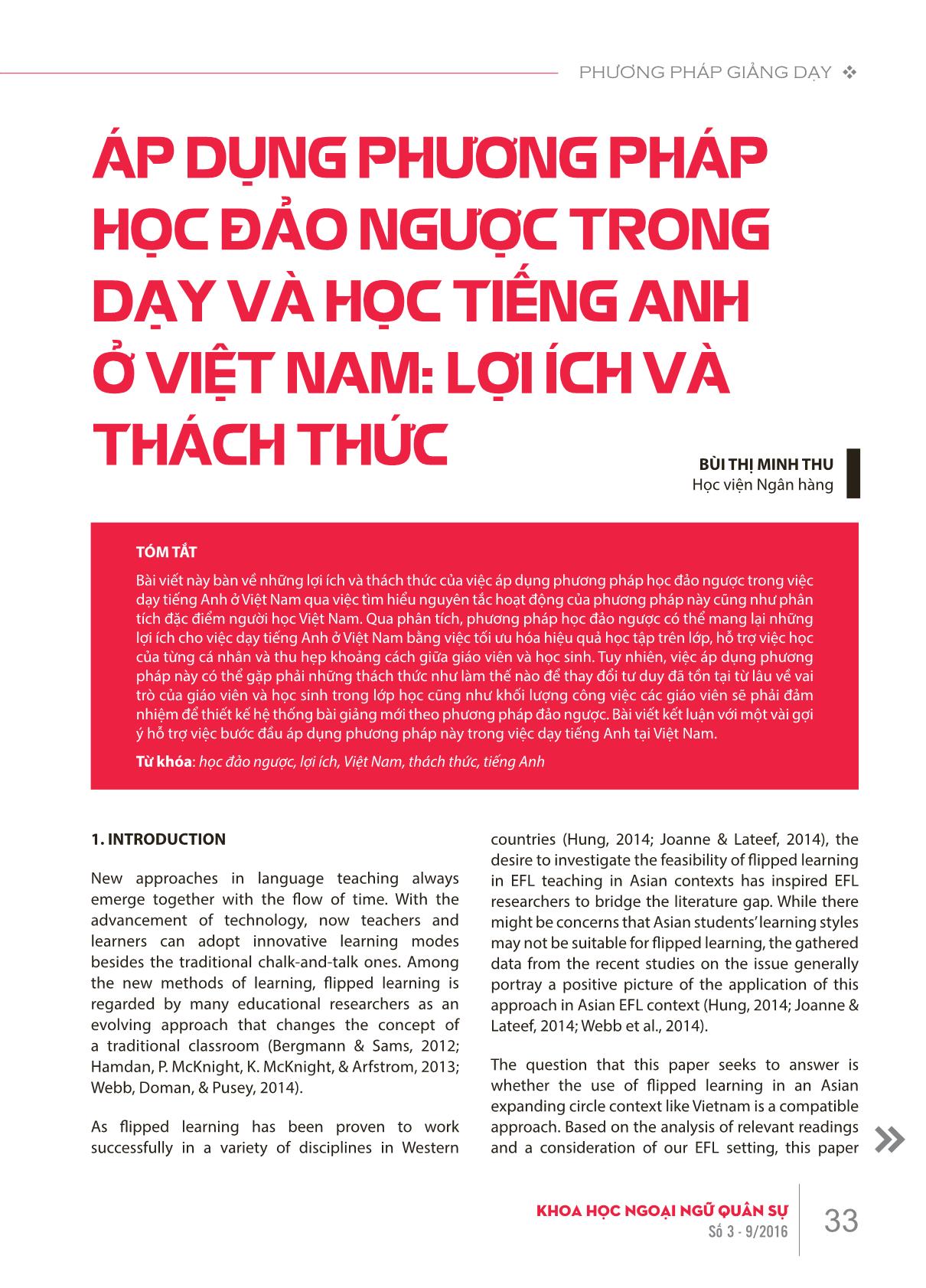
Trang 1
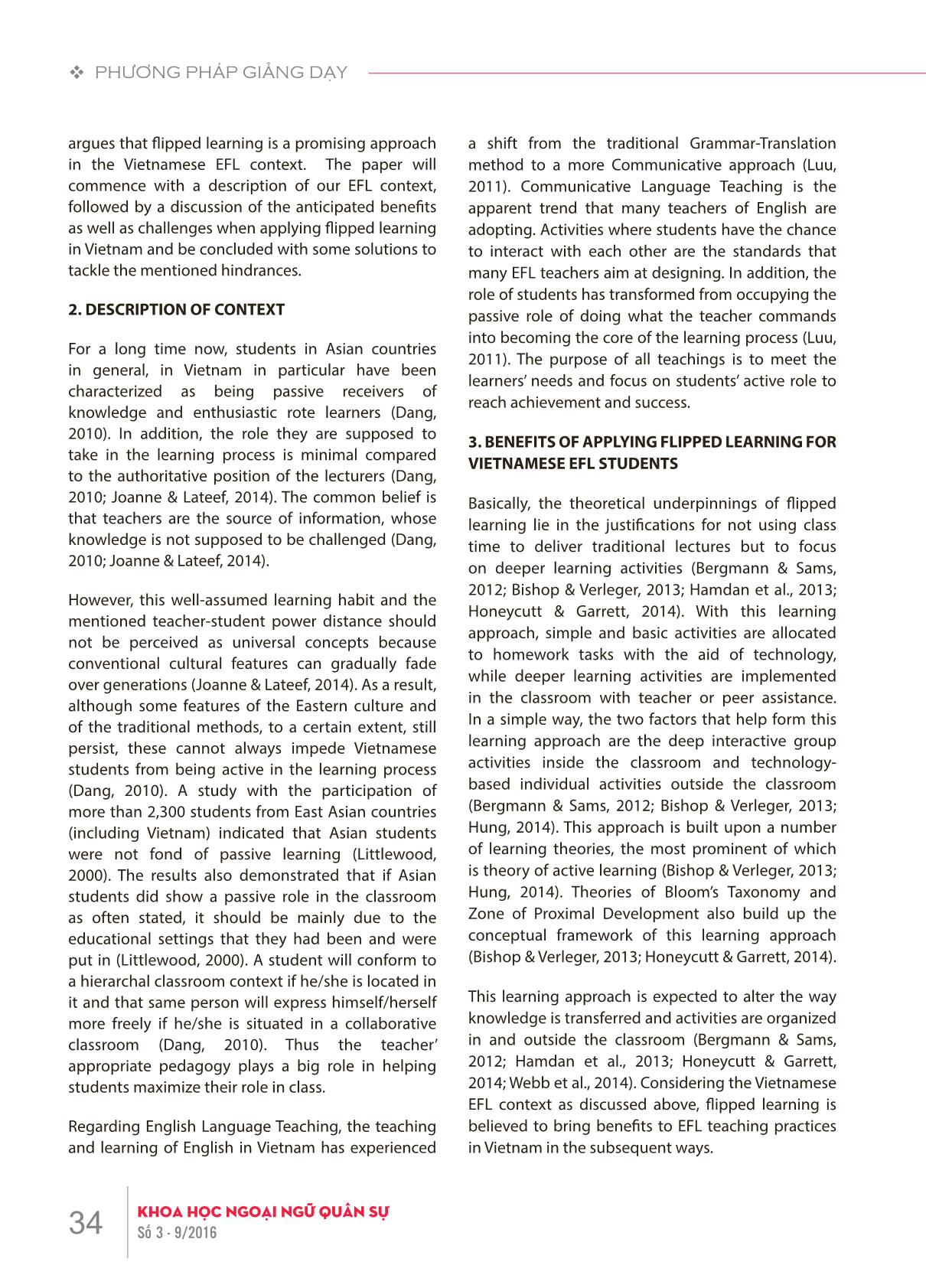
Trang 2

Trang 3
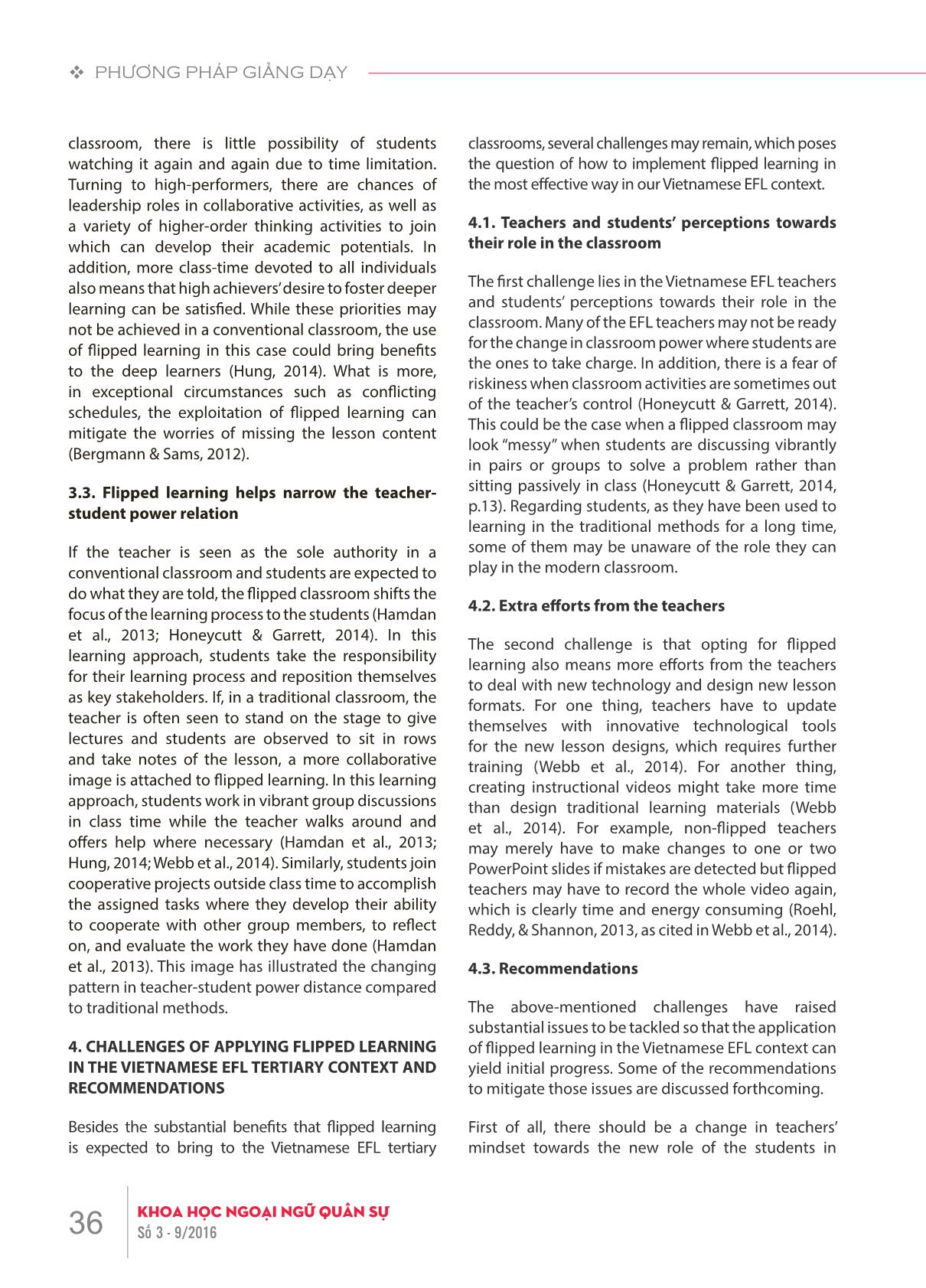
Trang 4
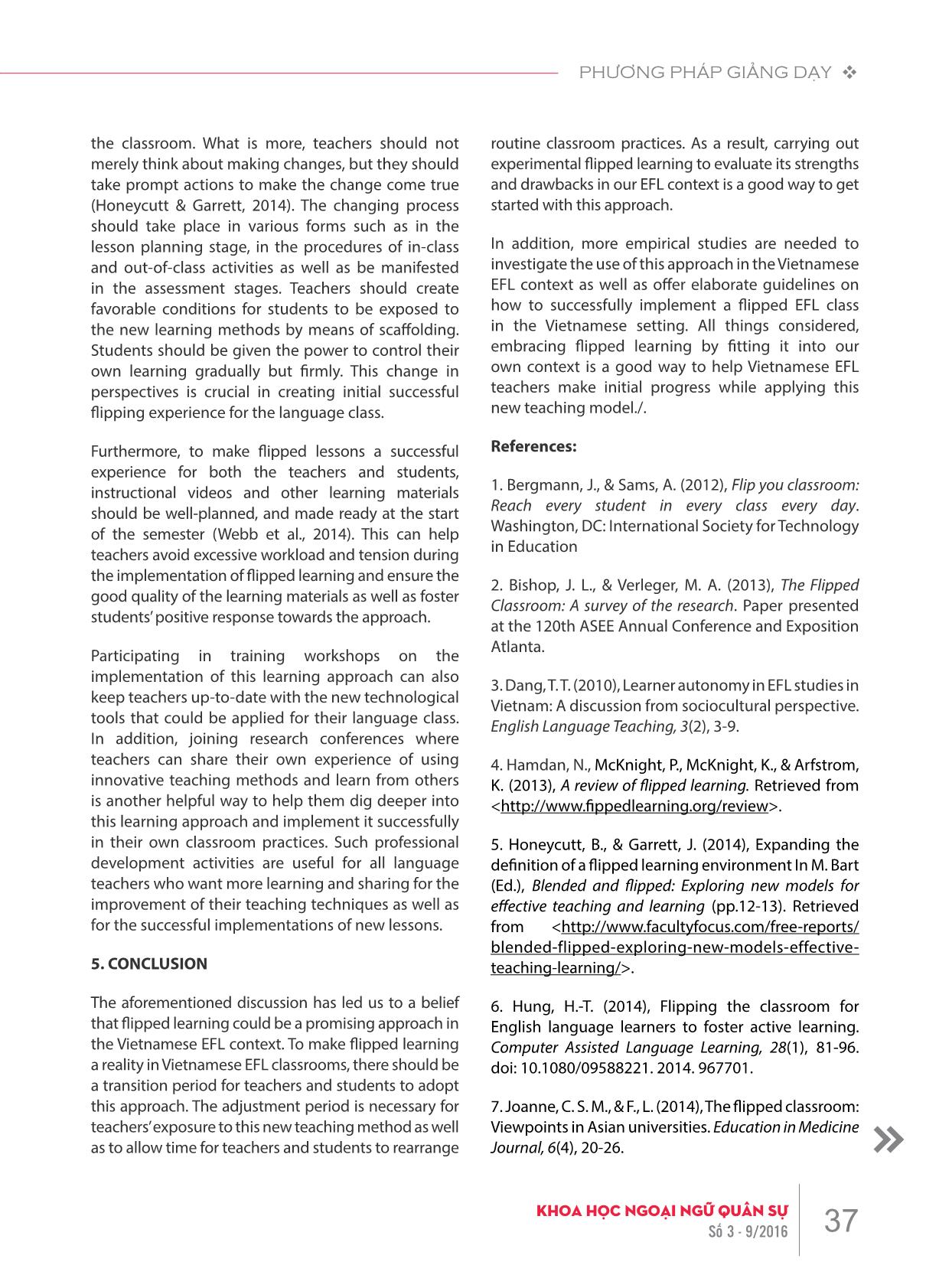
Trang 5
Tóm tắt nội dung tài liệu: Áp dụng phương pháp học đảo ngược trong dạy và học tiếng Anh ở Việt Nam: Lợi ích và thách thức
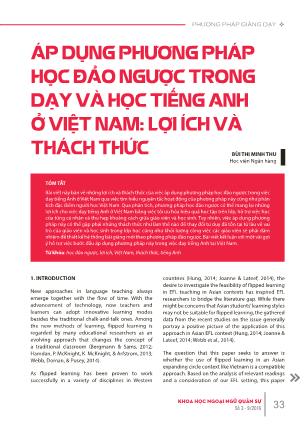
activities are implemented in the classroom with teacher or peer assistance. In a simple way, the two factors that help form this learning approach are the deep interactive group activities inside the classroom and technology- based individual activities outside the classroom (Bergmann & Sams, 2012; Bishop & Verleger, 2013; Hung, 2014). This approach is built upon a number of learning theories, the most prominent of which is theory of active learning (Bishop & Verleger, 2013; Hung, 2014). Theories of Bloom’s Taxonomy and Zone of Proximal Development also build up the conceptual framework of this learning approach (Bishop & Verleger, 2013; Honeycutt & Garrett, 2014). This learning approach is expected to alter the way knowledge is transferred and activities are organized in and outside the classroom (Bergmann & Sams, 2012; Hamdan et al., 2013; Honeycutt & Garrett, 2014; Webb et al., 2014). Considering the Vietnamese EFL context as discussed above, flipped learning is believed to bring benefits to EFL teaching practices in Vietnam in the subsequent ways. 35KHOA HỌC NGOẠI NGỮ QUÂN SỰSố 3 - 9/2016 PHƯƠNG PHÁP GIẢNG DẠY v 3.1. Flipped learning maximizes classroom effects for better learning outcome In the common situation of having limited class time in many of the Vietnamese universities and schools, the application of flipped learning is considered an apt solution to tackle the time issue and at the same time help students develop their academic skills in a number of ways. To start with, the “homework in class and class- work at home” model allows teachers and students to take effective use of class time compared to the traditional teaching methods (Webb et al., 2014, p.54). In a conventional Vietnamese EFL classroom, the application of modern technology to enhance teaching and learning quality in and out-of- class time is still limited. Nonetheless, in a flipped learning environment, students watch pre-recorded instructional videos at home and come to class for deeper discussion of the issue and further practice of language and problem-solving skills (Webb et al., 2014). The key strength of this learning approach is that it organizes learning activities in a logical and convenient way for the sake of students’ learning benefits. With this approach, students’ lower level thinking skills as presented in Bloom Taxonomy such as remembering and understanding can be practiced in students’ own time and place whereas higher order thinking skills such as applying, analyzing, creating and evaluating can be done in class with teachers’ support (Hamdan et al., 2013; Honeycutt & Garrett, 2014). For example, at home, EFL students can track down unknown words, take time to understand new concepts as well as listen and read for the content of the coming lesson in their own comfort (Hung, 2014). As these thinking skills do not require teachers’ assistance, flipped learning could free up teachers’ time of lecturing basic content in class. Class time is instead devoted to more challenging collaborative activities in pairs or groups. Secondly, by promoting higher order thinking skills, this learning approach is particularly suitable with the Vietnamese EFL high school and tertiary students. As this group of learners has greater ability for abstract thought and better commitment to what they are doing in comparison to their younger counterparts, the use of flipped learning is considered to be an appropriate approach. Finally yet importantly, flipped learning is believed to better enhance students’ language skills in comparison to regular classroom practices. Regarding listening and speaking skills, by letting students watch pre-recorded videos at their own time, which means students are provided with necessary vocabulary and having time to brainstorm for ideas before class, they can feel more well-prepared to take part in speaking activities in class (Hung, 2014). A similar outcome can be obtained with reading and writing skills. For instance, by watching writing lectures and doing basic tasks at home, students can understand the theory of writing formats before coming to class and class time can be dedicated to teachers’ further clarification of the unclear contents and students’ deeper writing practice. 3.2. Flipped learning supports individualized learning By catering for students’ individual needs, flipped learning is hoped to mitigate the issue of mixed- level EFL classes in many Vietnamese schools and universities and bring the enjoyment of flexible learning to all students. First, there are apparent benefits for not only low-performing students, but also high-performing students as well as students with special learning schedules. Concerning low- performing students, they can watch the pre- recorded lessons as many times as they wish for their understanding. As a result, poor achievers may feel more confident to take part in class-time activities due to their prior exposure to the learning materials. For example, if some students are weak at listening skill, they will feel worried and unready when being asked to join the speaking activities immediately after watching the video in class. However, flipped learning will give them the chance to access and have multiple-watching of the learning videos, which will eventually help them perform better and enhance their confidence in class. Even in cases when some students still feel unclear after attending the lesson, they can always go back to the videos for further understanding (Hung, 2014). This is a plus point of flipped learning to assist struggling students because if these activities are carried out in the traditional 36 KHOA HỌC NGOẠI NGỮ QUÂN SỰSố 3 - 9/2016 v PHƯƠNG PHÁP GIẢNG DẠY classroom, there is little possibility of students watching it again and again due to time limitation. Turning to high-performers, there are chances of leadership roles in collaborative activities, as well as a variety of higher-order thinking activities to join which can develop their academic potentials. In addition, more class-time devoted to all individuals also means that high achievers’ desire to foster deeper learning can be satisfied. While these priorities may not be achieved in a conventional classroom, the use of flipped learning in this case could bring benefits to the deep learners (Hung, 2014). What is more, in exceptional circumstances such as conflicting schedules, the exploitation of flipped learning can mitigate the worries of missing the lesson content (Bergmann & Sams, 2012). 3.3. Flipped learning helps narrow the teacher- student power relation If the teacher is seen as the sole authority in a conventional classroom and students are expected to do what they are told, the flipped classroom shifts the focus of the learning process to the students (Hamdan et al., 2013; Honeycutt & Garrett, 2014). In this learning approach, students take the responsibility for their learning process and reposition themselves as key stakeholders. If, in a traditional classroom, the teacher is often seen to stand on the stage to give lectures and students are observed to sit in rows and take notes of the lesson, a more collaborative image is attached to flipped learning. In this learning approach, students work in vibrant group discussions in class time while the teacher walks around and offers help where necessary (Hamdan et al., 2013; Hung, 2014; Webb et al., 2014). Similarly, students join cooperative projects outside class time to accomplish the assigned tasks where they develop their ability to cooperate with other group members, to reflect on, and evaluate the work they have done (Hamdan et al., 2013). This image has illustrated the changing pattern in teacher-student power distance compared to traditional methods. 4. CHALLENGES OF APPLYING FLIPPED LEARNING IN THE VIETNAMESE EFL TERTIARY CONTEXT AND RECOMMENDATIONS Besides the substantial benefits that flipped learning is expected to bring to the Vietnamese EFL tertiary classrooms, several challenges may remain, which poses the question of how to implement flipped learning in the most effective way in our Vietnamese EFL context. 4.1. Teachers and students’ perceptions towards their role in the classroom The first challenge lies in the Vietnamese EFL teachers and students’ perceptions towards their role in the classroom. Many of the EFL teachers may not be ready for the change in classroom power where students are the ones to take charge. In addition, there is a fear of riskiness when classroom activities are sometimes out of the teacher’s control (Honeycutt & Garrett, 2014). This could be the case when a flipped classroom may look “messy” when students are discussing vibrantly in pairs or groups to solve a problem rather than sitting passively in class (Honeycutt & Garrett, 2014, p.13). Regarding students, as they have been used to learning in the traditional methods for a long time, some of them may be unaware of the role they can play in the modern classroom. 4.2. Extra efforts from the teachers The second challenge is that opting for flipped learning also means more efforts from the teachers to deal with new technology and design new lesson formats. For one thing, teachers have to update themselves with innovative technological tools for the new lesson designs, which requires further training (Webb et al., 2014). For another thing, creating instructional videos might take more time than design traditional learning materials (Webb et al., 2014). For example, non-flipped teachers may merely have to make changes to one or two PowerPoint slides if mistakes are detected but flipped teachers may have to record the whole video again, which is clearly time and energy consuming (Roehl, Reddy, & Shannon, 2013, as cited in Webb et al., 2014). 4.3. Recommendations The above-mentioned challenges have raised substantial issues to be tackled so that the application of flipped learning in the Vietnamese EFL context can yield initial progress. Some of the recommendations to mitigate those issues are discussed forthcoming. First of all, there should be a change in teachers’ mindset towards the new role of the students in 37KHOA HỌC NGOẠI NGỮ QUÂN SỰSố 3 - 9/2016 PHƯƠNG PHÁP GIẢNG DẠY v the classroom. What is more, teachers should not merely think about making changes, but they should take prompt actions to make the change come true (Honeycutt & Garrett, 2014). The changing process should take place in various forms such as in the lesson planning stage, in the procedures of in-class and out-of-class activities as well as be manifested in the assessment stages. Teachers should create favorable conditions for students to be exposed to the new learning methods by means of scaffolding. Students should be given the power to control their own learning gradually but firmly. This change in perspectives is crucial in creating initial successful flipping experience for the language class. Furthermore, to make flipped lessons a successful experience for both the teachers and students, instructional videos and other learning materials should be well-planned, and made ready at the start of the semester (Webb et al., 2014). This can help teachers avoid excessive workload and tension during the implementation of flipped learning and ensure the good quality of the learning materials as well as foster students’ positive response towards the approach. Participating in training workshops on the implementation of this learning approach can also keep teachers up-to-date with the new technological tools that could be applied for their language class. In addition, joining research conferences where teachers can share their own experience of using innovative teaching methods and learn from others is another helpful way to help them dig deeper into this learning approach and implement it successfully in their own classroom practices. Such professional development activities are useful for all language teachers who want more learning and sharing for the improvement of their teaching techniques as well as for the successful implementations of new lessons. 5. CONCLUSION The aforementioned discussion has led us to a belief that flipped learning could be a promising approach in the Vietnamese EFL context. To make flipped learning a reality in Vietnamese EFL classrooms, there should be a transition period for teachers and students to adopt this approach. The adjustment period is necessary for teachers’ exposure to this new teaching method as well as to allow time for teachers and students to rearrange routine classroom practices. As a result, carrying out experimental flipped learning to evaluate its strengths and drawbacks in our EFL context is a good way to get started with this approach. In addition, more empirical studies are needed to investigate the use of this approach in the Vietnamese EFL context as well as offer elaborate guidelines on how to successfully implement a flipped EFL class in the Vietnamese setting. All things considered, embracing flipped learning by fitting it into our own context is a good way to help Vietnamese EFL teachers make initial progress while applying this new teaching model./. References: 1. Bergmann, J., & Sams, A. (2012), Flip you classroom: Reach every student in every class every day. Washington, DC: International Society for Technology in Education 2. Bishop, J. L., & Verleger, M. A. (2013), The Flipped Classroom: A survey of the research. Paper presented at the 120th ASEE Annual Conference and Exposition Atlanta. 3. Dang, T. T. (2010), Learner autonomy in EFL studies in Vietnam: A discussion from sociocultural perspective. English Language Teaching, 3(2), 3-9. 4. Hamdan, N., McKnight, P., McKnight, K., & Arfstrom, K. (2013), A review of flipped learning. Retrieved from . 5. Honeycutt, B., & Garrett, J. (2014), Expanding the definition of a flipped learning environment In M. Bart (Ed.), Blended and flipped: Exploring new models for effective teaching and learning (pp.12-13). Retrieved from < blended-flipped-exploring-new-models-effective- teaching-learning/>. 6. Hung, H.-T. (2014), Flipping the classroom for English language learners to foster active learning. Computer Assisted Language Learning, 28(1), 81-96. doi: 10.1080/09588221. 2014. 967701. 7. Joanne, C. S. M., & F., L. (2014), The flipped classroom: Viewpoints in Asian universities. Education in Medicine Journal, 6(4), 20-26.
File đính kèm:
 ap_dung_phuong_phap_hoc_dao_nguoc_trong_day_va_hoc_tieng_anh.pdf
ap_dung_phuong_phap_hoc_dao_nguoc_trong_day_va_hoc_tieng_anh.pdf

